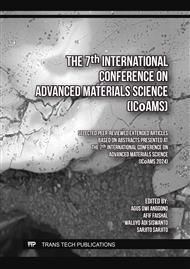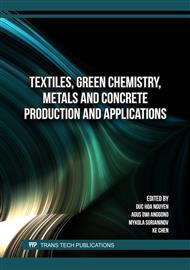[1]
Warmuzek M, Polkowska A. Micromechanism of Damage of the Graphite Spheroid in the Nodular Cast Iron During Static Tensile Test. Journal of Manufacturing and Materials Processing 2020;4:22.
DOI: 10.3390/jmmp4010022
Google Scholar
[2]
Liu J, Yan J, Zhao X, Fu B, Xue H, Zhang G, et al. Precipitation and evolution of nodular graphite during solidification process of ductile iron. China Foundry 2020;17:260–71.
DOI: 10.1007/s41230-020-0042-2
Google Scholar
[3]
Fragassa C. Investigating the Material Properties of Nodular Cast Iron from a Data Mining Perspective. Metals (Basel) 2022;12:1493.
DOI: 10.3390/met12091493
Google Scholar
[4]
Vaško A, Belan J, Tillová E. Static and dynamic mechanical properties of nodular cast irons. Archives of Metallurgy and Materials 2019:185–90.
DOI: 10.24425/amm.2019.126236
Google Scholar
[5]
Darmawan AS, Purboputro PI, Yulianto A, Anggono AD, Wijianto, Masyrukan, et al. Effect of Magnesium on the Strength, Stiffness and Toughness of Nodular Cast Iron. Materials Science Forum 2020;991:17–23.
DOI: 10.4028/www.scientific.net/MSF.991.17
Google Scholar
[6]
Catalán N, Ramos-Moore E, Boccardo A, Celentano D. Surface Laser Treatment of Cast Irons: A Review. Metals (Basel) 2022;12:562.
DOI: 10.3390/met12040562
Google Scholar
[7]
Bleicher C, Niewiadomski J, Kansy A, Kaufmann H. High-Silicon Nodular Cast Iron for Lightweight Optimized Wind Energy Components. International Journal of Offshore and Polar Engineering 2022;32:201–9.
DOI: 10.17736/ijope.2022.et06
Google Scholar
[8]
Singh A, Agarwal M. Influence of tempering conditions on the microstructure and mechanical properties of nodular cast iron. Australian Journal of Mechanical Engineering 2023;21:1778–89.
DOI: 10.1080/14484846.2022.2030090
Google Scholar
[9]
Hariningsih, Gustiani D, Sutiyoko. Effect of Quenching Media Variations on The Hardness and Microstructures of AISI O1 Tool Steel. Media Mesin: Majalah Teknik Mesin 2023;24:82–9.
DOI: 10.23917/mesin.v24i2.22191
Google Scholar
[10]
Anggono AD, Kholis N, Ngafwan. Structure and Mechanical Properties of Double Side Friction Stir Welded Aluminium AA6061 with the Addition of Cu Powder. Materials Science Forum 2022;1051:111–8.
DOI: 10.4028/www.scientific.net/MSF.1051.111
Google Scholar
[11]
Riyadi TWB, Siswanto WA, Zhu X. Interfacial formation of intermetallic Ni-Al-Ti systems formed by induction heating. Front Mech Eng 2022;8.
DOI: 10.3389/fmech.2022.1005646
Google Scholar
[12]
Anyanwu KO, Nzei HO, Onuoha C, Ehirim VI. The effects of heat input and electrode type on the mechanical properties of welded A309 stainless steel using a shielded metal arc welding. Applied Research and Smart Technology (ARSTech) 2023;4:43–52.
DOI: 10.23917/arstech.v4i1.1149
Google Scholar
[13]
Li B, Ying P, Gao Y, Hu W, Wang L, Zhang Y, et al. Heterogeneous Diamond-cBN Composites with Superb Toughness and Hardness. Nano Lett 2022;22:4979–84.
DOI: 10.1021/acs.nanolett.2c01716
Google Scholar
[14]
Mazuro P, Pieńkowska J, Rostek E. Influence of Various Heat Treatments on Hardness and Impact Strength of Uddeholm Balder: Cr-Mo-V-Ni Novel Steel Used for Engine Construction. Materials 2021;14:4943.
DOI: 10.3390/ma14174943
Google Scholar
[15]
Zubar T, Fedosyuk V, Tishkevich D, Kanafyev O, Astapovich K, Kozlovskiy A, et al. The Effect of Heat Treatment on the Microstructure and Mechanical Properties of 2D Nanostructured Au/NiFe System. Nanomaterials 2020;10:1077.
DOI: 10.3390/nano10061077
Google Scholar
[16]
Çalık A, Dokuzlar O, Uçar N. The effect of heat treatment on mechanical properties of 42CrMo4 steel. Journal of Achievements in Materials and Manufacturing Engineering 2020;1:5–10.
DOI: 10.5604/01.3001.0014.0811
Google Scholar
[17]
Di Schino A, Gaggiotti M, Testani C. Heat Treatment Effect on Microstructure Evolution in a 7% Cr Steel for Forging. Metals (Basel) 2020;10:808.
DOI: 10.3390/met10060808
Google Scholar
[18]
Wang B, Pan Y, Liu Y, Lyu N, Barber GC, Wang R, et al. Effects of quench-tempering and laser hardening treatment on wear resistance of gray cast iron. Journal of Materials Research and Technology 2020;9:8163–71.
DOI: 10.1016/j.jmrt.2020.05.006
Google Scholar
[19]
Chen C, Feng A, Liu B, Wei Y, Song X. Effect of quench-tempering and laser quenching on the microstructure and properties of high-chromium cast iron. Journal of Materials Research and Technology 2022;19:2759–73.
DOI: 10.1016/j.jmrt.2022.06.022
Google Scholar
[20]
Salas Vicente F, Carcel Carrasco J, Fernández Antoni R, Ferrero Taberner JC, Pascual Guillamón M. Hardness Prediction in Quenched and Tempered Nodular Cast Iron Using the Hollomon-Jaffe Parameter. Metals (Basel) 2021;11:297.
DOI: 10.3390/met11020297
Google Scholar
[21]
Wang X-Q, Tao Z, Hassan MK. Post-fire behaviour of high-strength quenched and tempered steel under various heating conditions. J Constr Steel Res 2020;164:105785.
DOI: 10.1016/j.jcsr.2019.105785
Google Scholar
[22]
Jo H, Kang M, Park G-W, Kim B-J, Choi CY, Park HS, et al. Effects of Cooling Rate during Quenching and Tempering Conditions on Microstructures and Mechanical Properties of Carbon Steel Flange. Materials 2020;13:4186.
DOI: 10.3390/ma13184186
Google Scholar
[23]
Singh P, Singh S. Effect of quenching media on microstructural evolution, mechanical and wear properties of AISI4135 steel. Proc Inst Mech Eng C J Mech Eng Sci 2021;235:5616–25.
DOI: 10.1177/0954406221990050
Google Scholar
[24]
Díaz Moreno JM, García Vázquez C, González Montesinos MT, Ortegón Gallego F, Viglialoro G. Industrial Steel Heat Treating: Numerical Simulation of Induction Heating and Aquaquenching Cooling with Mechanical Effects. Mathematics 2021;9:1203.
DOI: 10.3390/math9111203
Google Scholar
[25]
Wang J, Qian R, Huang S, Shang C. Effect of Double-Quenching on the Hardness and Toughness of a Wear-Resistant Steel. Metals (Basel) 2022;13:61.
DOI: 10.3390/met13010061
Google Scholar
[26]
Chen C, Feng A, Liu B, Wei Y, Song X. Effect of quench-tempering and laser quenching on the microstructure and properties of high-chromium cast iron. Journal of Materials Research and Technology 2022;19:2759–73.
DOI: 10.1016/j.jmrt.2022.06.022
Google Scholar
[27]
Dewangan S, Behera S, Chowrasia MKr. Comparative analysis into mechanical properties and microstructural attributes of quenched and tempered 0.2%-C steel. World Journal of Engineering 2020;17:127–33.
DOI: 10.1108/WJE-11-2019-0327
Google Scholar
[28]
Dewangan S, Chattopadhyaya S. Analysing Effect of Quenching and Tempering into Mechanical Properties and Microstructure of 304-SS Welded Plates. Acta Metallurgica Slovaca 2022;28:140–6.
DOI: 10.36547/ams.28.3.1556
Google Scholar
[29]
Tkachev E, Borisov S, Belyakov A, Kniaziuk T, Vagina O, Gaidar S, et al. Effect of quenching and tempering on structure and mechanical properties of a low-alloy 0.25C steel. Materials Science and Engineering: A 2023;868:144757.
DOI: 10.1016/j.msea.2023.144757
Google Scholar
[30]
Wang F, Qian D, Mao H, He Y, Shu B. Evolution of microstructure and mechanical properties during tempering of M50 steel with Bainite/Martensite duplex structure. Journal of Materials Research and Technology 2020;9:6712–22.
DOI: 10.1016/j.jmrt.2020.04.075
Google Scholar
[31]
Zeng TY, Li W, Wang NM, Wang W, Yang K. Microstructural evolution during tempering and intrinsic strengthening mechanisms in a low carbon martensitic stainless bearing steel. Materials Science and Engineering: A 2022;836:142736.
DOI: 10.1016/j.msea.2022.142736
Google Scholar
[32]
Hu Z, Liu C, Du Y, Wang X, Zhu X, Jiang B. Effects of Tempering Temperature on Mechanical and Tribological Behavior of Ductile Iron. Lubricants 2022;10:326.
DOI: 10.3390/lubricants10120326
Google Scholar
[33]
Singh A, Agarwal M. Influence of tempering conditions on the microstructure and mechanical properties of nodular cast iron. Australian Journal of Mechanical Engineering 2023;21:1778–89.
DOI: 10.1080/14484846.2022.2030090
Google Scholar
[34]
Salas Vicente F, Carcel Carrasco J, Fernández Antoni R, Ferrero Taberner JC, Pascual Guillamón M. Hardness Prediction in Quenched and Tempered Nodular Cast Iron Using the Hollomon-Jaffe Parameter. Metals (Basel) 2021;11:297.
DOI: 10.3390/met11020297
Google Scholar
[35]
Chen C, Feng A, Liu B, Wei Y, Song X. Effect of quench-tempering and laser quenching on the microstructure and properties of high-chromium cast iron. Journal of Materials Research and Technology 2022;19:2759–73.
DOI: 10.1016/j.jmrt.2022.06.022
Google Scholar
[36]
Fragassa C. Investigating the Material Properties of Nodular Cast Iron from a Data Mining Perspective. Metals (Basel) 2022;12:1493.
DOI: 10.3390/met12091493
Google Scholar
[37]
Oktadinata H, Dafi MS, Prajitno DH. Microstructure Evolution and Hardness Properties of Nodular Cast Iron for Varying Tempering Time. Key Eng Mater 2022;935:3–9.
DOI: 10.4028/p-h1ao57
Google Scholar
[38]
Morsdorf L, Kashiwar A, Kübel C, Tasan CC. Carbon segregation and cementite precipitation at grain boundaries in quenched and tempered lath martensite. Materials Science and Engineering: A 2023;862:144369.
DOI: 10.1016/j.msea.2022.144369
Google Scholar



